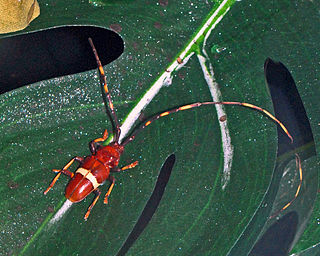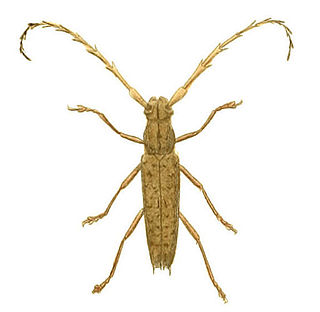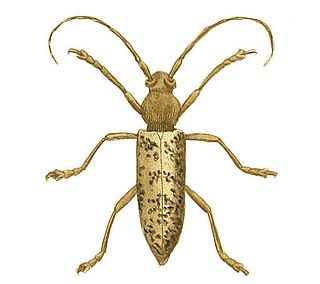
Dru Drury was a British collector of natural history specimens and an entomologist. He had specimens collected from across the world through a network of ship's officers and collectors including Henry Smeathman. His collections were utilized by many entomologists of his time to describe and name new species and is best known for his book Illustrations of natural history which includes the names and descriptions of many insects, published in parts from 1770 to 1782 with copperplate engravings by Moses Harris.

Eacles imperialis, the imperial moth, is a Nearctic member of the family Saturniidae and subfamily Ceratocampinae. The species was first described by Dru Drury in 1773.

Dikelocephalus is a genus of very large trilobites of up to 50 cm (20 in) long, that lived during the last 3 million years of the Cambrian (Sunwaptan). Their fossils are commonly found as disarticulated sclerites, in the upper Mississippi Valley and in Canada (Alberta). The exoskeleton is rounded anteriorly, with the thorax and sides of the tailshield slightly tapering to about ⅔× of the width across the base of the spines at the back of the headshield. At the side corners of the pygidium there may be triangular or hooked spines, pointing backwards, while between the spines the posterior margin is at a 30-75° angle with the lateral margin, gently convex or nearly straight. If pygidial spines are lacking, the margin is gradually rounded. The thorax has 12 segments.

Sternotomis pulchra is a species of beetle belonging to the family Cerambycidae.

Orthomegas cinnamomeus is a species of beetle in the genus Orthomegas of the family Cerambycidae. It was described by Carl Linnaeus in his landmark 1758 10th edition of Systema Naturae. It is found in Hispaniola, Trinidad, Colombia, Venezuela, the Guianas, Brazil, Ecuador, Peru and Bolivia.
Archodontes melanopus is a root-boring species of beetle in the family Cerambycidae, the only species in the genus Archodontes. It is endemic to Central America and the south-eastern United States, and bores the roots of oaks and other hardwoods.
Cosmisoma plumicorne is a species of beetle in the family Cerambycidae. It was described by Dru Drury in 1782.

Trachyderes succinctus is a species of beetle in the family Cerambycidae. It was described by Carl Linnaeus in his landmark 1758 10th edition of Systema Naturae.
Plinthocoelium virens is a species of beetle in the family Cerambycidae. It was described by Dru Drury in 1770.
Neoclytus longipes is a species of beetle in the family Cerambycidae. It was described by Dru Drury in 1773.
Eburia quadrimaculata is a species of beetle in the family Cerambycidae.

Elaphidion irroratum is a species of beetle in the family Cerambycidae. It was described by Carl Linnaeus in his 1767 12th edition of Systema Naturae.

Elaphidion spinicorne is a species of beetle in the family Cerambycidae. It was described by Dru Drury in 1773 from Jamaica.

Enaphalodes atomarius is a species of beetle in the family Cerambycidae. It was described by Dru Drury in 1773 from New York City.

Phileurus didymus is a species of wood-feeding beetle of the family Scarabaeidae.

Greta diaphanus, the Antillean clearwing, is a species of clearwing (ithomiine) butterflies, named by Dru Drury in 1773.
Sternotomis mirabilis is a genus of long-horned beetle belonging to the family Cerambycidae. It was first described in 1773 by Dru Drury from Sierra Leone.
Prosopocera bipunctata is a species of flat-faced longhorn beetles in the subfamily Lamiinae. It was first described by Dru Drury in 1773, from Sierra Leone.

Polyrhaphis spinosa is a species of longhorn beetles of the subfamily Lamiinae. It was first described by Dru Drury in 1773.

Gaeana maculata is the type species of cicadas in the genus Gaeana. It was first described by Dru Drury in 1773, from China.












